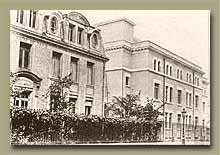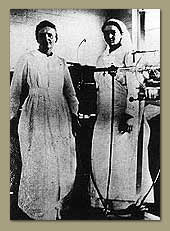 |
| The
Radium Institute. After Germany declared war on France in 1914,
only two people remained at the Institute: Curie and “our
mechanic who could not join the army because of serious heart
trouble.” |
|

 Radiology at the Front
Radiology at the Front
 HREE
GERMAN BOMBS fell on Paris on September 2, 1914, about a month
after Germany declared war on France. By that time construction
of the Radium Institute was complete, although Curie had not yet
moved her lab there. Curie's researchers had been drafted, like
all other able-bodied Frenchmen. HREE
GERMAN BOMBS fell on Paris on September 2, 1914, about a month
after Germany declared war on France. By that time construction
of the Radium Institute was complete, although Curie had not yet
moved her lab there. Curie's researchers had been drafted, like
all other able-bodied Frenchmen.
The Radium Institute's
work would have to wait for peacetime. But surely there were ways
in which Curie could use her scientific knowledge to advance the war
effort. |
“I am resolved to put all my
strength at the service of my adopted country, since I cannot
do anything for my unfortunate native country just now...”
--letter from Marie Curie to Paul Langevin, January 1, 1915
|
As the German army swept
toward Paris, the government decided to move to Bordeaux. France's
entire stock of radium for research was the single gram in Curie's
lab. At the government's behest, Curie took a Bordeaux-bound train
along with government staff, carrying the precious element in a heavy
lead box. Unlike many, however, Curie felt her place was in Paris.
After the radium was in a Bordeaux safe-deposit box, she returned
to Paris on a military train. |
|
X-rays could save
soldiers' lives, she realized, by helping doctors see bullets, shrapnel,
and broken bones. She convinced the government to empower her to
set up France's first military radiology centers. Newly named Director
of the Red Cross Radiology Service, she wheedled money and cars
out of wealthy acquaintances.
She convinced automobile
body shops to transform the cars into vans, and begged manufacturers
to do their part for their country by donating equipment. By late
October 1914, the first of 20 radiology vehicles she would equip was
ready. French enlisted men would soon dub these mobile radiology installations,
which transported X-ray apparatus to the wounded at the battle front,
petites Curies (little Curies). |
 |
| This “petite
Curie,” which brought X-rays to the Front in World War
I, was displayed in Paris in 1998 during the commemoration of
the 100th anniversary of the discovery of radium. |
|
 |
|
Marie and Irène with X-ray equipment at a
military hospital. After training Irène as a radiologist for
a year, Curie deemed her daughter capable of directing a battle-front
radiological installation on her own.
READ
Curie's words
|
|
 LTHOUGH
CURIE HAD LECTURED about X-rays at the Sorbonne, she had no
personal experience working with them. Intending to operate the
petite Curie herself if necessary, she learned how to drive a car
and gave herself cram courses in anatomy, in the use of X-ray equipment,
and in auto mechanics. As her first radiological assistant she chose
her daughter Irène, a very mature and scientifically well-versed
17-year-old. Accompanied by a military doctor, mother and daughter
made their first trip to the battle front in the autumn of 1914. LTHOUGH
CURIE HAD LECTURED about X-rays at the Sorbonne, she had no
personal experience working with them. Intending to operate the
petite Curie herself if necessary, she learned how to drive a car
and gave herself cram courses in anatomy, in the use of X-ray equipment,
and in auto mechanics. As her first radiological assistant she chose
her daughter Irène, a very mature and scientifically well-versed
17-year-old. Accompanied by a military doctor, mother and daughter
made their first trip to the battle front in the autumn of 1914.
“The
use of the X-rays during the war saved the lives of many wounded
men; it also saved many from long suffering and lasting infirmity.”--Marie
Curie
Would Irène be traumatized
by the sight of the soldiers' horrific wounds? To guard against a
bad reaction, Curie was careful to display no emotion herself as she
carefully recorded data about each patient. |
|
Irène followed her
mother's example. Heedless of the dangers of over-exposure to X-rays,
mother and daughter were inadequately shielded from the radiation
that helped save countless soldiers' lives. After the war the French
government recognized Irène's hospital work by awarding her a military
medal. No such official recognition came to Curie. Perhaps her role
in the Langevin affair was not yet forgiven.
� 2000 -
American Institute of Physics
|
|

